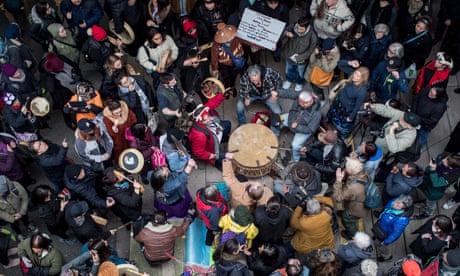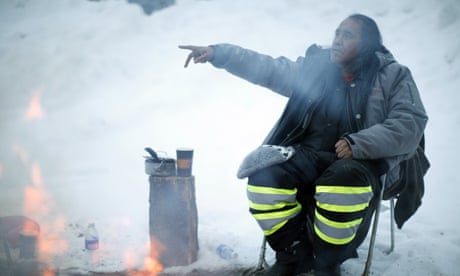This article is more than 1 year old

Notes from strategy session for raid on Wet’suwet’en nation’s ancestral lands show commanders argued for ‘lethal overwatch’Jaskiran Dhillon in Wet’suwet’en territory and Will ParrishFri 20 Dec 2019 10.30 GMT
Canadian police were prepared to shoot Indigenous land defenders blockading construction of a natural gas pipeline in northern British Columbia, according to documents seen by the Guardian.
Notes from a strategy session for a militarized raid on ancestral lands of the Wet’suwet’en nation show that commanders of Canada’s national police force, the Royal Canadian Mounted Police (RCMP), argued that “lethal overwatch is req’d” – a term for deploying an officer who is prepared to use lethal force.

The RCMP commanders also instructed officers to “use as much violence toward the gate as you want” ahead of the operation to remove a roadblock which had been erected by Wet’suwet’en people to control access to their territories and stop construction of the proposed 670km (416-mile) Coastal GasLink pipeline (CGL).
In a separate document, an RCMP officer states that arrests would be necessary for “sterilizing [the] site”.
Wet’suwet’en people and their supporters set up the Gidimt’en checkpoint in December 2018 to block construction of the pipeline through this region of mountains and pine forests 750 miles north of Vancouver.
On 7 January, RCMP officers – dressed in military-green fatigues and armed with assault rifles – descended on the checkpoint, dismantling the gate and arresting 14 people.Q&A
Who are the Wet’suwet’en?
The checkpoint lies 22km east of a camp operated by a house group of the Wet’suwet’en called the Unist’ot’en, which has been at the center of the struggle against the pipeline.
The camp is one of several instances where Indigenous people in British Columbia have reinhabited ancestral territory that falls outside of demarcated reservations, in what they refer to as “reoccupation”.
Unist’ot’en spokesperson Freda Huson (Howilhkat) said that the RCMP’s militarized posture during the raid was consistent with a long history of colonial violence.
“In our experience, since first contact, RCMP have been created by the federal government to dispossess Indigenous peoples of their lands,” Huson said. “They have proven [that] through their harassment of my people to support Coastal GasLink in invading our territories.”
Police records seen by the Guardian include transcripts from police strategy sessions, reports filed after the raid and audio and video files.
One document noted that the Wet’suwet’en possessed “firearms for hunting/sustenance” but police intelligence indicated that there was “no single threat indicating that [land defenders] will use firearms”.
An RCMP spokesperson declined to comment on the specific content of the documents, saying they were merely carrying out a December 2018 injunction against people who interfere with the CGL pipeline.
“During the planning for the enforcement of the court-ordered injunction, the RCMP took the remote location of the Morice River Bridge into account and ensured that enough police officers were present in the area to keep the peace,” the spokesperson said. “We also took into consideration the unpredictable nature of what we could face in the remote area, and so we moved additional police resources including members of the tactical and emergency response teams to provide support.”

The revelations come as the Wet’suwet’en camps brace for a provincial supreme court ruling on an injunction applied for by the pipeline builder TC Energy (formerly TransCanada), which seeks to permanently restrict the Wet’suwet’en from blocking access to pipeline work sites.
The pipeline would run from the Dawson Creek area of northern British Columbia to a facility near Kitimat on the Pacific coast. CGL has begun road-building and clear-cutting on the right-of-way, and the company intends to start construction in early-2020.
https://interactive.guim.co.uk/uploader/embed/2019/01/canada_pipeline/giv-39027WNQdUQvvvuN/
Founded in 2009, Unist’ot’en camp was the first among a constellation of Indigenous-led uprisings against fossil fuel pipelines in North America – including Keystone XL, Trans Mountain, Enbridge Line 3, Dakota Access and Bayou Bridge.
Like most Indigenous people in British Columbia, the Wet’suwet’en have never relinquished their land to the Canadian government by treaty, land sale or surrender.
In a 1997 ruling, the supreme court of Canada determined that aboriginal land ownership had never been given up across the Wet’suwet’en’s 22,000 km sq of territory.
Wet’suwet’en leaders say they are defending their right to protect themselves and future generations from irreparable harm. The pipeline would run directly beneath the Morice River, a river system several municipalities rely on.

The documents show that ahead of the raid, the RCMP deployed an array of surveillance, including heavily armed police patrols, a jet boat, helicopter, drone technology, heat-sensing cameras and close monitoring of key land defenders’ movements and social media postings.
Police established a “media exclusion zone”, blocking reporters from accessing the area. They took care to hide their carbine rifles on the approach to the roadblock because the “optics” of the weapons were “not good”, according to one of the documents.
The documents also show close collaboration between the RCMP and TC Energy: police officers attended company planning sessions and daily “tailgate” meetings, and were privy to CGL’s legal strategy.
The RCMP were prepared to arrest children and grandparents: “No exception, everyone will be arrested in the injunction area,” a document reads. Another makes reference to possible child apprehension by social services – a troubling disclosure given the violent history of residential schooling in Canada and the disproportionate number of Indigenous children currently in the child welfare system.
“The police are here to support the invasion of Indigenous territories,” said Tlingit land defender Anne Spice. “It is what they’ve always done. Now, they watch us when we travel to pick berries. They ‘patrol’ the roads where we hunt. They harass us and profile us under the guise of ‘public safety’.”
Since the January raid, an RCMP detachment known as the Community Industry Safety Office has maintained a large presence in an effort to forestall any resistance to pipeline construction.
Armed RCMP officers can be seen patrolling the area, and three police trailers are tucked away in the woods alongside the access road. Drones and helicopters often circle overhead. CGL has also retained two private security firms that track Indigenous people’s movements.
According to the RCMP spokesperson, the police detachment will remain in place in Wet’suwet’en lands “as long as deemed necessary”.

The RCMP Community Industry Response Group (CIRG) has also recently been deployed to monitor and suppress Indigenous people fighting the proposed Trans Mountain tar sands pipeline, which would pass through a separate area of British Columbia and which officially began construction last month.
One of the Gidimt’en land protectors, Molly Wickham (Sleydo’), from the clan’s Grizzly House, described the CIRG detachment in her people’s territory as a violation of “free, prior and informed consent” between a settler state and Indigenous people — a principle enshrined in the United Nations Declaration on the Rights of Indigenous People.
“What I’ve witnessed over the last year is not only violent oppression by RCMP and the state on 7 January, but the continuing occupation of our territories and surveillance of our people and camp by CIRG,” she said.
The RCMP’s suppression of Indigenous dissent against resource extraction is rooted in its founding as a paramilitary entity 150 years ago.
In the late 1800s, the RCMP (formerly the Northwest Mounted Police) carried out surveillance, violent displacement and relocation of Indigenous peoples onto reserves, and the forcible removal of Indigenous children from their families in order to place them in residential schools. Advocates say it was the police force which enabled the Canadian government to seize Indigenous homelands and undermine Native sovereignty.
More recently, the Canadian state has thrown its national security apparatus behind oil and gas development – often directly at Indigenous people’s expense.
The 2015 Anti-Terrorism Act, Bill C-51, sanctions the criminalization of Indigenous environmentalists by enhancing surveillance and legal powers against any potential interference with Canada’s “critical infrastructure” or “territorial integrity”. Land defenders such as Freda Huson have been identified in RCMP intelligence reports as “aboriginal extremists”.
Despite the onset of winter, Wet’suwet’en land defenders remain at the camps to protect their lands and waters. As construction crews dynamite the land in preparation for laying pipe, and RCMP and private security forces patrol the territory, they trap for food and build new cabins.
“We will continue to resist, to insist on respect for our way of life,” said Spice.
This article was amended on 30 December 2019. An earlier version described “lethal overwatch” as “a term for deploying snipers”. To clarify, it describes the deployment of an officer who is prepared to use lethal force, who may or may not be positioned as a sniper. An earlier version also included the quote “sterilizing the site” from an RCMP record. The word “the” does not actually appear in the record.